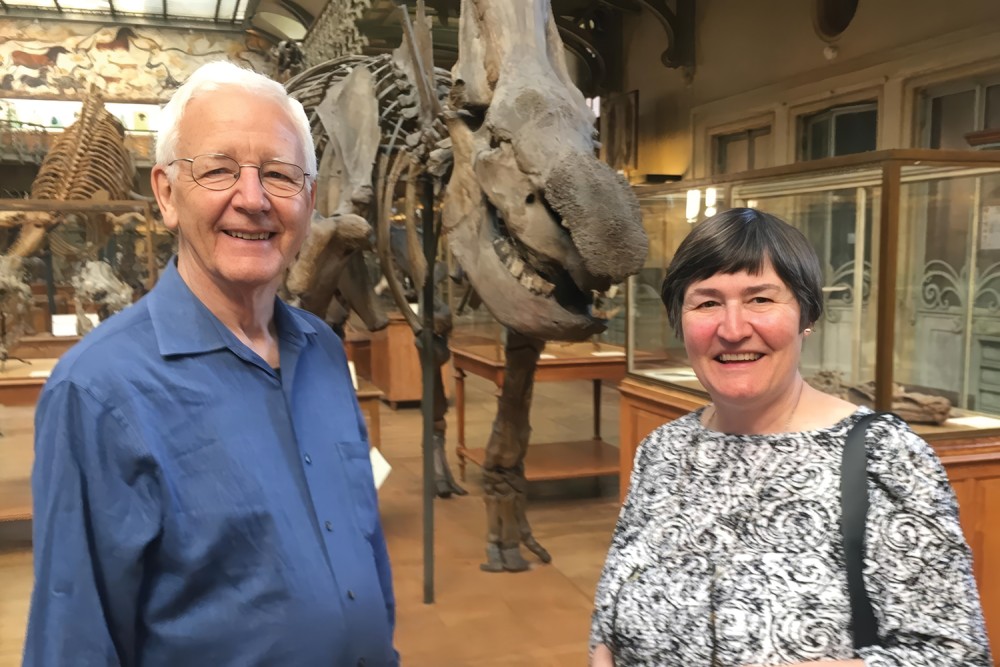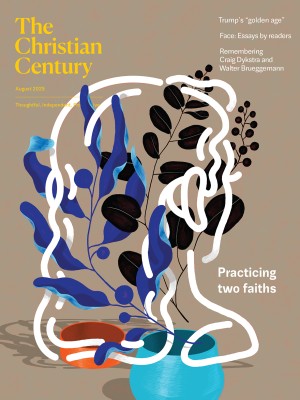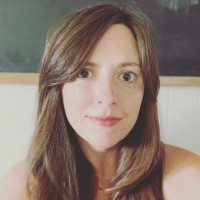Science is finally catching up with Teilhard de Chardin
Frank and Mary Frost, the filmmakers behind a recent PBS documentary about the Jesuit paleontologist, have long seen him as a true visionary.

Filmmakers Frank and Mary Frost (Photo courtesy of Frank Frost Productions, LLC)
What can the work of an early 20th-century French priest and scientist tell us about the possibilities of artificial intelligence? In Teilhard: Visionary Scientist, Frank and Mary Frost tell the story of Pierre Teilhard de Chardin’s life and show how scientific and technological advances, especially those in AI, are making his work appear eerily prophetic.
Who was Teilhard de Chardin?
Frank: Born in 1881, he became a Jesuit priest, a paleontologist, a mystic, and a futuristic thinker. In 1925 he was silenced and exiled from France by his Jesuit superiors, who were wary of his enthusiasm for evolutionary theory, especially the dangers they thought it posed for religious belief.
Read our latest issue or browse back issues.
Mary: Ironically, his exile in China launched him to international fame for his key role in the discovery of Peking man—a much sought-after missing link between early hominids and modern humans.
Frank: The Jesuits suppressed his theological writing during his lifetime, forbidding him to lecture or publish on religious topics. Scientists dismissed his theory of cosmogenesis—the universe as a process, increasing in complexity of consciousness toward an “omega point”—as unserious. His spiritual essays and books were only published after his death in 1955. For decades his writing was more popular with writers and artists than with his coreligionists and scientific colleagues. Flannery O’Connor, Annie Dillard, Don DeLillo, and Philip K. Dick were all inspired by him.
How did Teilhard run afoul of the Catholic Church?
Frank: He didn’t mean to. He did so in all innocence and conviction, because he was deeply in love with his science of the earth. He thought that he had learned something, as a scientist studying evolution, that the church would love, because it could help them to address the modern world and increase dialogue with scientists. So he went about advocating evolution robustly. Then he was challenged by a theologian of the old school who said, if you really believe in evolution, then you don’t believe in Adam and Eve. And if you don’t believe in Adam and Eve, then what happens to the doctrine of original sin?
Teilhard didn’t really comprehend, I think, how fundamental the concept of original sin was to church authority, which for centuries had been built on the necessity of salvation from it. Teilhard had devised a different approach, one that reached back before Aristotle and Aquinas to early scientists who believed in a dynamic universe that was always changing and growing—but he didn’t say original sin was not a true doctrine. He was trying to think about it in a different way, a way that he could reconcile with science.
Teilhard thought Christ came to fulfill the world, not to get rid of its sin. He wasn’t so brief and explicit as that, but that’s where he was going. All his life, he kept finding new ways to write about original sin—privately. He didn’t want to let go of the church’s positions, but he had to find a reasonable way to think about it, because the bottom line was that because he was a geologist, he knew that Adam and Eve did not exist and that the earth was not 6,000 years old. This was the arc that really determined the course of his life—this question of original sin.
Teilhard believed religion and science were not in conflict. This made him unpopular with the church of his time—and with other scientists.
Mary: Teilhard died in 1955, before the Second Vatican Council—before the idea that you should embrace the world, not shun it, became quite important to the church. Then attitudes toward his work began to shift. This was a disruptive period in history and culture. You had the beginnings of the hippie movement and New Age religion. People were picking up on the notion that consciousness was really the key to understanding the spiritual world. Catholicism, for a time, turned from a religion of fear to a religion of hope. That was very exciting for a while. And then it faded.
And the scientists?
Frank: They were slower to come around. In 1961, Peter Medawar, who won the Nobel Prize for medicine, reviewed Teilhard’s posthumous book The Phenomenon of Man and said that it was all hogwash. Science in general really didn’t go for Teilhard. They considered him a lightweight, being only a geologist and paleontologist, not a physicist or a biologist. They said, He’s a dreamer, he’s a good poet, but he’s not a good scientist.
How has that changed?
Frank: In 1995, Wired magazine published an article on what Teilhard called the noosphere. Back in the 1920s, he had theorized the evolution of a global mind, or noosphere, from the Greek word nous for mind. The magazine writer saw the internet as the noosphere Teilhard had imagined, a global mind through which we all communicate. Of course, that’s a bit of an overstatement. But now, the term noosphere is almost universally accepted.
What we’ve seen since then is a steep rising interest in Teilhard. Basically, we see science and technology catching up with him. What he dreamed about 50, 60, 70 years ago—the inclusion of subjectivity in scientific studies, even the sciences working together and with other disciplines, becoming less siloed and fractured—is now important to the conversation and cannot be ignored.
You began work on this documentary more than 15 years ago. How did the story change as you worked on it?
Mary: When we started the research, we were working from our experience of the ’60s and ’70s, and our impression was that Teilhard was a visionary. And he is, of course, and was. Then we discovered the George Barbour collection at Georgetown—12 boxes of original papers from Teilhard’s paleontology research in China. We realized he’d written more scientific papers than pieces on philosophical or religious issues. He was a down-in-the dirt scientist.
Today he is very much revered as one of the cofounders of paleontology in China. On our research trip, the paleontology division of the Chinese Academy of Science introduced us to four locations we didn’t even know existed, where he had done original excavations. Two are still being excavated today. So we had to shift our perspective to include more of Teilhard the scientist, not just Teilhard the visionary. And that made all the difference.
Now it seems like any time I read a story about cognitive science and technology and the rapid developments in AI, there is a reference to Teilhard.
Frank: And that’s a huge shift. In the ’60s, it was all about spirituality. Today, his spirituality is almost secondary.
How do people now see Teilhard as prophetic regarding AI?
Frank: The key critical insight into Teilhard’s theory of evolution—as opposed to the Darwinian or Lamarckian theories—is that it’s ultimately the evolution of consciousness. Teilhard said that from the very beginning of the big bang, all reality had consciousness, and that the history of the arc of evolution is the complexification and intensification of consciousness, or cosmogenesis. He thought we as humans had reached a high state of evolution with self-reflective consciousness—the awareness of consciousness—but we were not finished. The next phase would be the noosphere.
Mary: He did use the phrase “global mind.” But was he talking about the internet? He also talked about deep time. He wasn’t anticipating rapid changes. We’re not talking next year.
Frank: I think what he saw was something a step further than the internet, kind of like ESP. I think he imagined that we would not necessarily need words to communicate. That eventually, we would evolve to have global communication that is pure consciousness. Right now we’re only experiencing it in technological form.
It’s a little scary to contemplate.
Frank: You understand, then, why he got such violent pushback a hundred years ago. He was out there. And this was scary for religious authorities, you know? So they sent him to China, thinking they’d be rid of him. Then he discovered Peking man!
Mary: One of the reasons I think we fear AI is that in pop culture, AI has usually been imagined as robots. The fear was these robots were going to become sentient, and they were going to become threatening. But in the last ten years we have realized a more transhumanist vision: the real evolution of technology and AI is that it’s becoming incorporated into existing human forms. So it’s not that artificial intelligence is going its own way and has become a threat to us. We are becoming artificially intelligent—through medicine, through nanotechnology. We are realizing that consciousness can be code.
In the last four or five years of his life, Teilhard was kind of obsessed with the notion of the physical human on the cusp of a new stage of evolution, what he called the ultrahuman. In this ultrahuman, the basic human body didn’t change, but the human consciousness became more intense. He also imagined it would be more loving, more free. I think if he’d lived another 15 years and seen the technological changes happening, he would have been very interested in examining how technology blends with and becomes a part of us.
Before our conversation, I read an essay by Teilhard expert Ilia Delio, a scientist and Catholic theologian who appears in your documentary. I copied down this quote: “Technology is an extension of biology. We are creating the tools, and in turn, the tools are creating us.”
Frank: Yes! I believe that she consciously or unconsciously filters her development of thought through Teilhard.
My impulse is to fear this unknown trajectory we’re on with AI and the ways it might be evil. I've been a techno-pessimist. How are Teilhard’s ideas being adopted and deployed by people with a much more optimistic vision of tech and AI?
Mary: I mean, we’ve seen that happen in so many other things. He would have cautioned, I think, that you have to keep ethics involved when you’re dealing with AI, that you have to keep the spirit part of it and not just focus on what the technology can do.
Frank: I refer to his writings as my lodestone. One thing he said was that we need to follow the truth to where it leads. You have to try everything that’s possible—within ethical limits, of course—but you can’t be afraid. Teilhard’s whole message was one of assurance and hope. He based this on his belief in Christ, because he believed in a risen Christ—a cosmic Christ—as the omega point. He thought, however bleak this may sound right now, that there is always a future we’re being drawn into.






